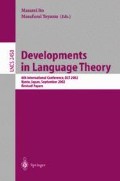Abstract
It is shown that an infinite prime sequence can be generated in real-time by a cellular automaton having 1-bit inter-cell communications.
Access this chapter
Tax calculation will be finalised at checkout
Purchases are for personal use only
Preview
Unable to display preview. Download preview PDF.
References
M. Arisawa: On the generation of integer series by the one-dimensional iterative arrays of finite state machines (in Japanese). The Trans. of IECE, 71/8 Vol.54-C, No.8, pp.759–766, (1971).
C. R. Dyer: One-Way Bounded Cellular Automata. Information and Control, Vol.44, pp.261–281, (1980).
P. C. Fischer: Generation of primes by a one-dimensional real-time iterative array. J. of ACM, Vol.12, No.3, pp.388–394, (1965).
I. Korec: Real-time generation of primes by a one-dimensional cellular automaton with 11 states. Proc. of 22nd Intern. Symp. on MFCS’ 97, Lecture Notes in Computer Science, 1295, pp.358–367, (1997).
J. Mazoyer: A minimal time solution to the firing squad synchronization problem with only one bit of information exchanged. Technical report of Ecole Normale Superieure de Lyon, No.89-03, pp.51, April, (1989).
J. Mazoyer: On optimal solutions to the firing squad synchronization problem. Theoret. Comput. Sci., 168, pp.367–404, (1996).
J. Mazoyer and V. Terrier: Signals in one-dimensional cellular automata. Theoretical Computer Science, 217, pp.53–80, (1999).
A. R. Smith: Real-time language recognition by one-dimensional cellular automata. J. of Computer and System Sciences, 6, pp.233–253, (1972).
V. Terrier: On real-time one-way cellular array. Theoretical Computer Science, 141, pp.331–335, (1995).
V. Terrier: Language not recognizable in real time by one-way cellular automata. Theoretical Computer Science, 156, pp.281–287, (1996).
H. Umeo: Cellular Algorithms with 1-Bit Inter-Cell Communications. Proc. of MFCS’98 Satellite Workshop on Cellular Automata (Eds. T. Worsch and R. Vollmar), pp.93–104, Interner Bericht 19/98, University of Karlsruhe, (1998).
H. Umeo and M. Inada: A Design of Cellular Algorithms for 1-Bit Inter-Cell Communications. Proc. of the Fifth International Workshop on Parallel Image Analysis, IWPIA’97, pp.51–62, (1997).
H. Umeo: Linear-time recognition of connectivity of binary images on 1-bit inter-cell communication cellular automaton. Parallel Computing, 27, pp.587–599, (2001).
H. Umeo and N. Kamikawa: A design of real-time non-regular sequence generation algorithms and their implementations on cellular automata with 1-bit inter-cell communications. Fundamenta Informaticae, 52, No.1–3, pp.255–273, (2002).
T. Worsch: Linear Time Language Recognition on Cellular Automata with Restricted Communication, Proc. of LATIN 2000:Theoretical Informatics (Eds. G. H. Gonnet, D. Panario and A. Viola), LNCS 1776, pp.417–426, (2000).
Author information
Authors and Affiliations
Editor information
Editors and Affiliations
Rights and permissions
Copyright information
© 2003 Springer-Verlag Berlin Heidelberg
About this paper
Cite this paper
Umeo, H., Kamikawa, N. (2003). An Infinite Prime Sequence Can Be Generated in Real-Time by a 1-Bit Inter-cell Communication Cellular Automaton. In: Ito, M., Toyama, M. (eds) Developments in Language Theory. DLT 2002. Lecture Notes in Computer Science, vol 2450. Springer, Berlin, Heidelberg. https://doi.org/10.1007/3-540-45005-X_30
Download citation
DOI: https://doi.org/10.1007/3-540-45005-X_30
Published:
Publisher Name: Springer, Berlin, Heidelberg
Print ISBN: 978-3-540-40431-6
Online ISBN: 978-3-540-45005-4
eBook Packages: Springer Book Archive

